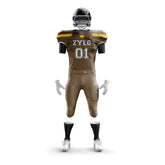Best Materials for Custom Varsity Jackets: A Buyer’s Guide for 2025
Introduction
Custom varsity jackets are a timeless fashion staple, blending retro charm with modern personalization. Whether you're designing jackets for a sports team, school, or fashion brand, choosing the right materials is crucial for quality and longevity.
In this 2025 buyer’s guide, we’ll break down the best fabrics, linings, and trims for custom varsity jackets. You’ll learn which materials offer durability, comfort, and style—helping you make an informed decision.
1. Outer Shell Fabrics: Durability & Style
The outer shell is the most visible part of a varsity jacket, so it needs to be both tough and stylish. Here are the top choices for 2025:
A. Wool – Classic & Warm
- Pros: Naturally insulating, soft, and breathable. Wool is the traditional choice for varsity jackets, offering a premium look.
- Cons: Requires careful maintenance (dry cleaning recommended).
- Best for: Cold climates and vintage-style designs.
B. Leather (Genuine or Faux) – Edgy & Durable
- Pros: Extremely durable, water-resistant, and ages beautifully. Faux leather is a vegan-friendly alternative.
- Cons: Genuine leather is expensive and needs conditioning.
- Best for: A bold, rugged aesthetic.
C. Nylon & Polyester – Lightweight & Weather-Resistant
- Pros: Affordable, water-resistant, and easy to clean. Great for athletic teams.
- Cons: Less breathable than wool or cotton.
- Best for: Activewear and budget-friendly designs.
D. Cotton Twill – Soft & Versatile
- Pros: Breathable, comfortable, and easy to customize with embroidery.
- Cons: Not as warm as wool.
- Best for: Everyday wear and casual styles.
2. Lining Materials: Comfort Matters
A good lining enhances comfort and extends the jacket’s lifespan. Here are the best options:
A. Satin – Smooth & Luxurious
- Pros: Glides on easily, adds a premium feel.
- Cons: Can snag if not cared for properly.
B. Polyester – Durable & Moisture-Wicking
- Pros: Affordable, quick-drying, and long-lasting.
- Cons: Less breathable than natural fabrics.
C. Mesh – Breathable & Lightweight
- Pros: Great for ventilation, ideal for athletes.
- Cons: Less insulation in cold weather.
D. Quilted Lining – Extra Warmth
- Pros: Adds insulation without bulk.
- Cons: Slightly heavier.
3. Sleeve Materials: Flexibility & Fit
Most varsity jackets feature contrasting sleeves. Popular choices include:
A. Genuine Leather Sleeves
- Pros: Durable and stylish.
- Cons: Higher cost.
B. PU Leather (Vegan Alternative)
- Pros: Cruelty-free and more affordable.
- Cons: Less breathable.
C. Ribbed Knit Sleeves
- Pros: Stretchy, comfortable, and classic.
- Cons: Can wear out faster than leather.
4. Customization: Cuffs, Collars & Lettering
Personalization is what makes a varsity jacket unique. Consider these materials for trims:
A. Chenille Patches – Soft & Textured
- Best for embroidered letters and mascots.
B. Embroidery Thread (Polyester or Rayon)
- Polyester is more durable; rayon has a shinier finish.
C. Metal Buttons vs. Plastic Buttons
- Metal adds a premium touch; plastic is lightweight and affordable.
5. Sustainability in 2025: Eco-Friendly Options
With growing demand for sustainable fashion, consider:
- Recycled polyester (made from plastic bottles).
- Organic cotton (chemical-free farming).
- Plant-based leather alternatives (e.g., mushroom or pineapple leather).
Conclusion
Choosing the right materials for your custom varsity jacket ensures durability, comfort, and style. Whether you prefer classic wool, sleek leather, or modern synthetic blends, this 2025 guide helps you make the best choice.
Ready to design your perfect varsity jacket? Pick high-quality fabrics, linings, and trims for a jacket that stands the test of time!


